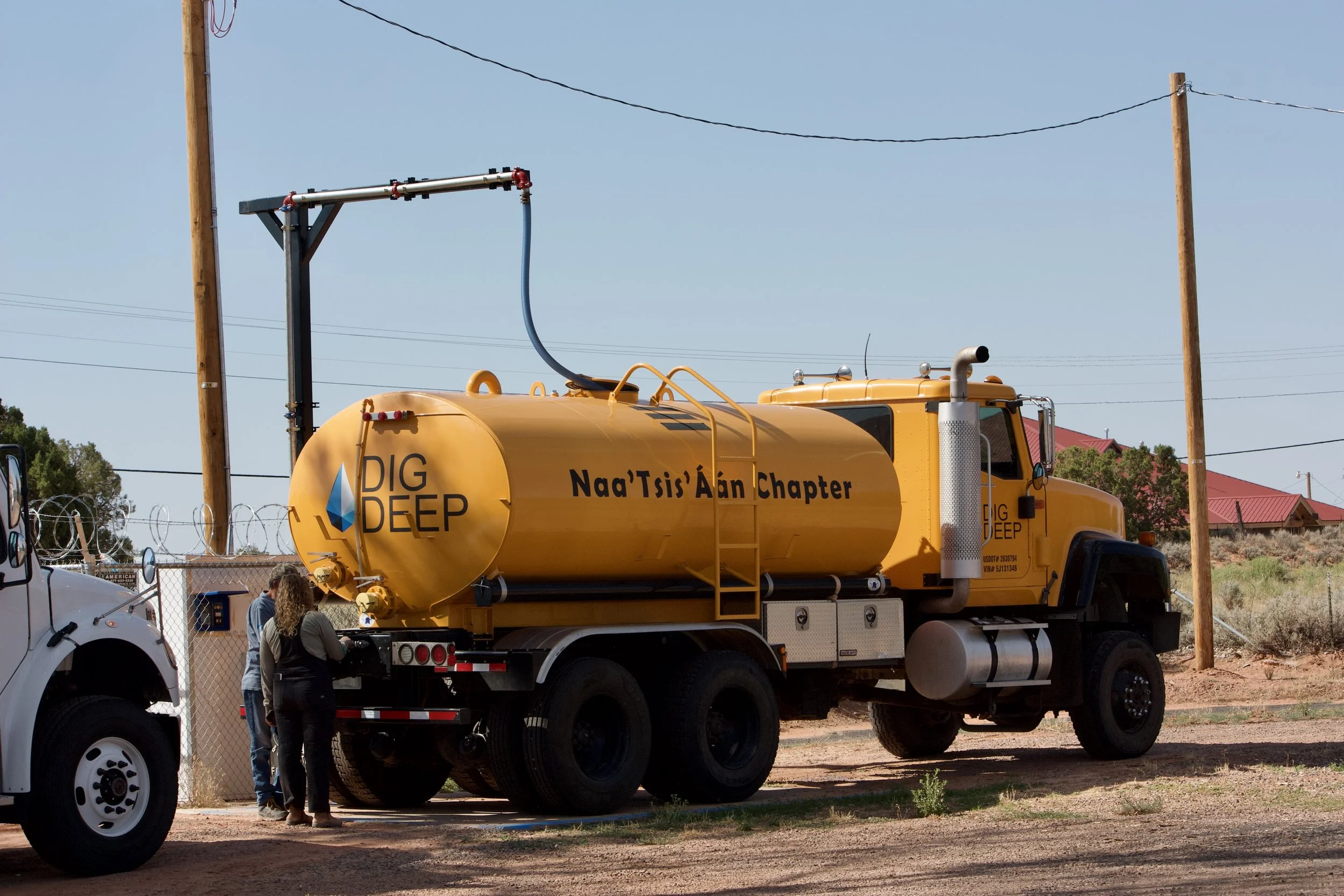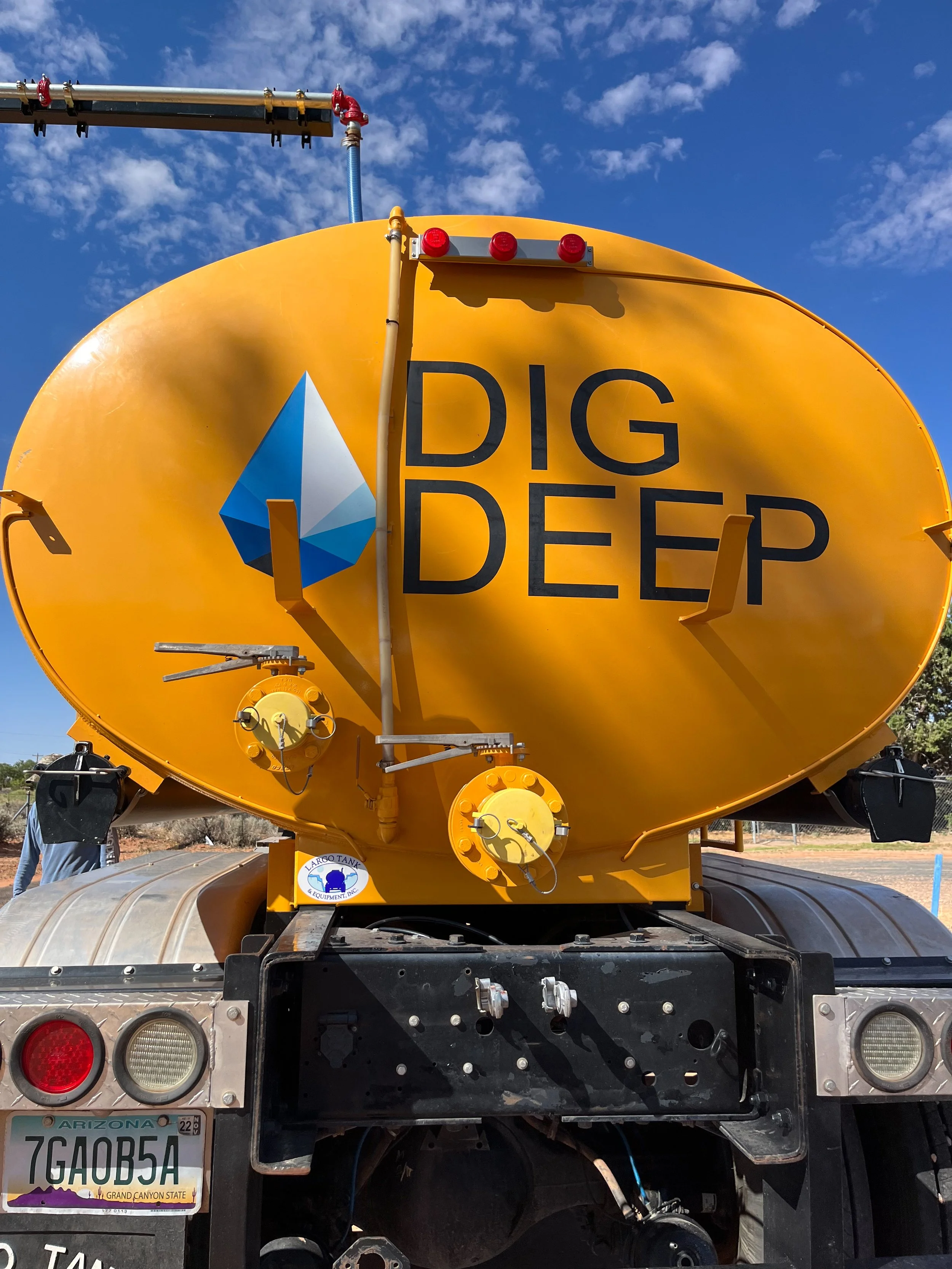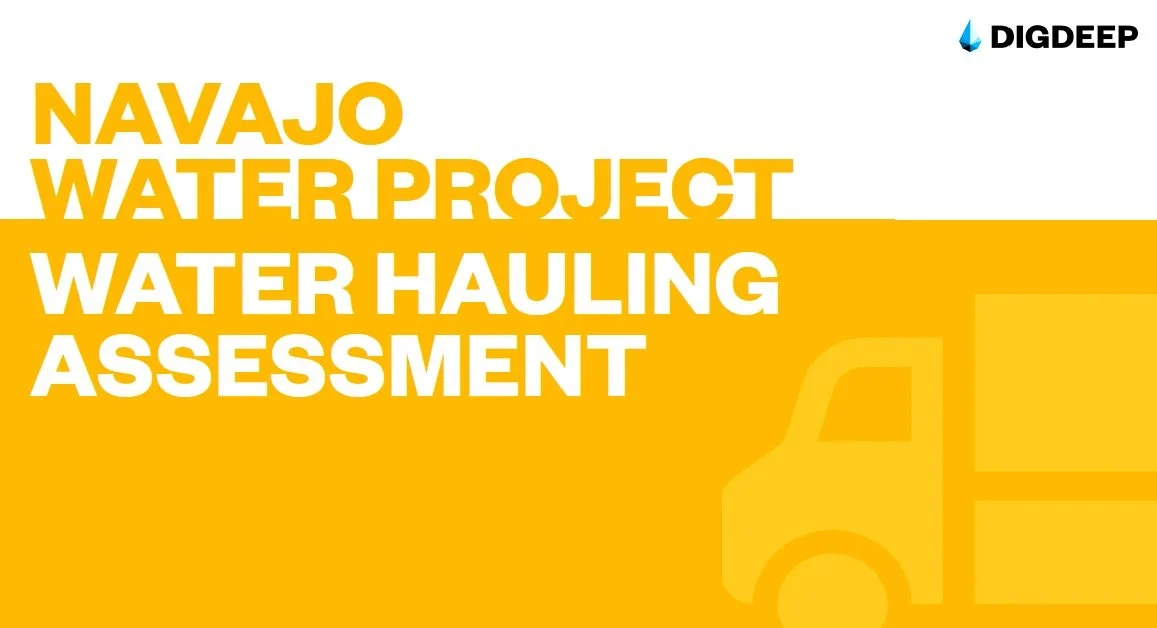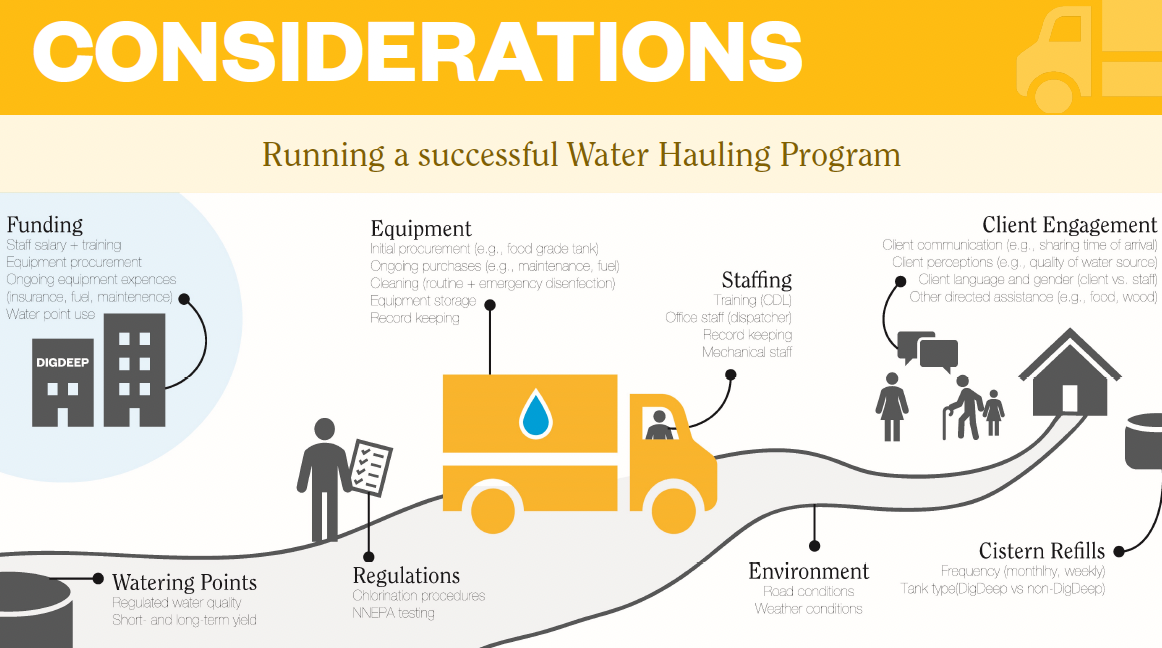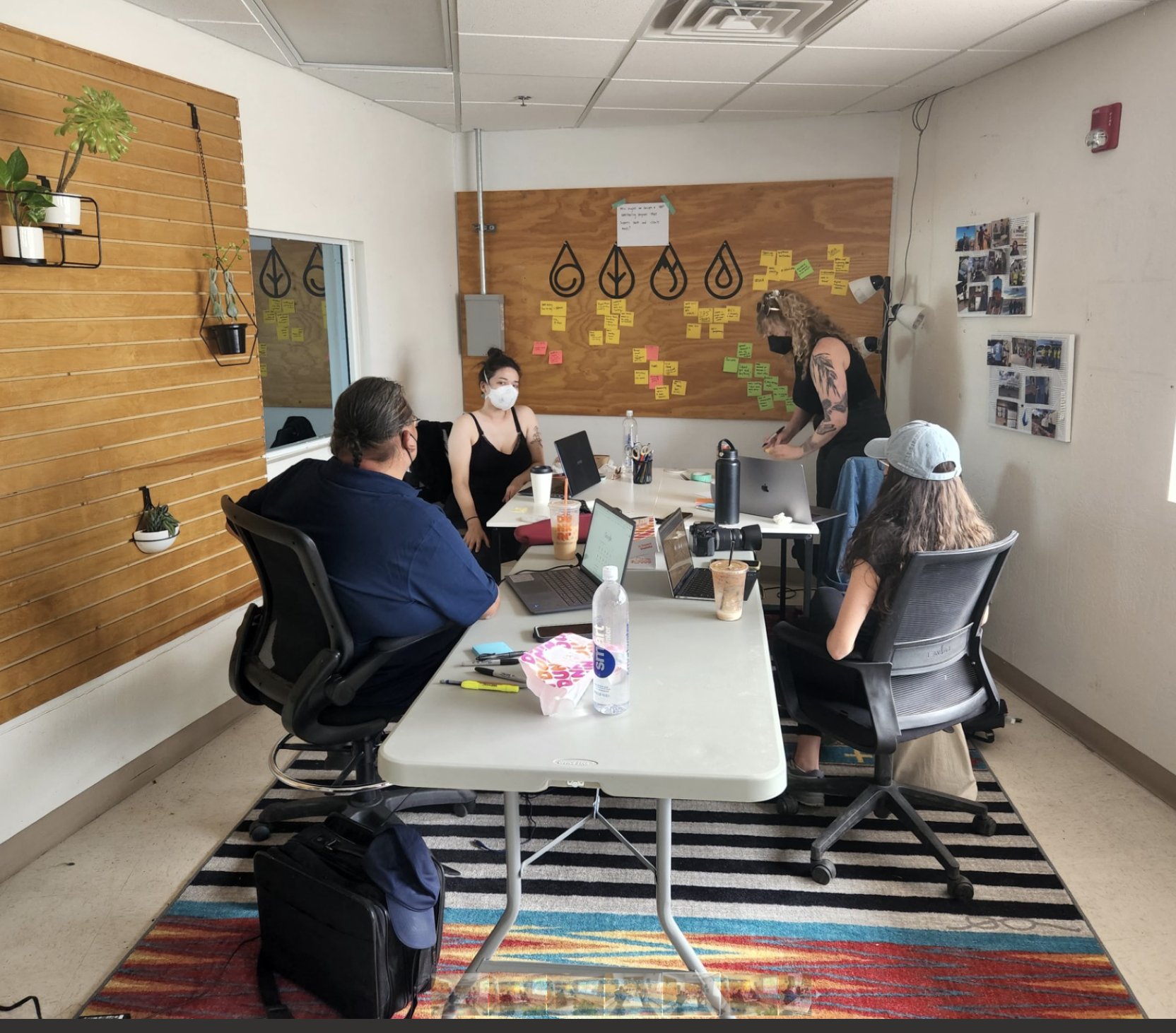
Co-creating a supportive water hauling program
How might we understand the challenges and needs of water haulers on the Navajo Nation in order to better support their day-to-day operations?
Collaborators
DigDeep Navajo Water Project Water and Solar Technicians and Project Managers;
Research collaborators include Katie Janns, Susan Lamb , and Dean Dempsy (Diné).
The Navajo Nation and water hauling
The Navajo Nation is home to Diné people who have lived in concert with land that is now Colorado, New Mexico, and Utah since time immemorial. Due to historical injustices and systematic racism, many communities on the Navajo Nation do not have access to basic sanitation needs, paved roads, or internet.
It is estimated by DigDeep that 30% of the Navajo Nation is without access to potable water or sanitation systems. Because of this, community members must drive to watering points in nearby towns, run by the Navajo Tribal Utility Authority, or to boarder towns to haul water back to their house. During the COVID-19 pandemic DigDeep transitioned to emergency water hauling services, more than doubling the number of homes that they served across the Navajo Nation.
Water haulers drove tanker trucks with 3,000 gallons of water down dirt roads to deliver water to remote families. Depending on road conditions, water haulers could drive over 2 hours one way to reach a home.
As water hauling became an increasingly important aspect of DigDeep’s work, there was a desire to formalize and create standard operating procedures for field staff. In order to do this the research team first wanted to understand the needs of water hauling operators and what would be supportive to their work.
Field Visits lead to a deeper understanding of water hauler’s needs
Across the Navajo Water Project there are three project sites - Dilkon, AZ, Navajo Mountain, UT, and Baca-Prewitt, New Mexico.
We conducted multiple field site visits interviewing water haulers and field staff across three field sites to understand their needs and stressors in performing water hauling duties. We found that water haulers were often working double duty without training, acting as both field technicians and water truck operators. Water haulers felt a sense of pride in delivering water to community members, but did not have the organizational support to fully prioritize water hauling.
Interviews with project managers underscored the various priorities at play.
We conducted interviews with project managers to better understand their perspectives of the current water hauling program, their daily tasks around water operations, and how they would like to see the program change. We found that each field site had different methods of conducting their water hauling program.
User personas and affinity diagraming helped us understand the competing needs of water hauling operators.
Joan Yazzie
Ocupation: Water Truck Driver for DigDeep
Lives in Tuba City, AZ works in Shonto, AZ
35 years old
Married with 3 kids
Takes care of her dad in Tonalea, AZ the evenings after work.
Goals and Needs
Joan is always busy and always helping, which is part of why she loves her job as a water hauler at DigDeep so much. She shows up at work every day with a smile on her face no matter how early she clocks in. She enjoys getting to see community members on a daily basis and often spends time hearing about their life and needs. She knows the going ons of everyone and also knows who needs what. During the pandemic she was making food and supply deliveries after work hours on her own time.
Joan needs extra time during her day to day to make sure that her job is done well and she can visit with community members - as she sees herself as a representative of DigDeep and wants to make sure to show up 100%.
Challenges
Sometimes there is a lot of pressure to get as many water deliveries done in a day as possible, which makes Joan feel stressed that she might not have time visit with community members. She also feels like this doesn’t value the time she puts into making sure community members are heard in their needs.
Additionally, because Joan feels rushed for time, she sometimes skips a few steps when filling up the water tank and more than once has forgotten to rinse off the hose or replace the fill cap.
Elmer Begay
Occupation: Water and Solar technician for DigDeep
Lives in Tolani Lake, works in Dilkon, AZ
60 years old
Married, No kids at home
Has a garden and a few sheep
Goals and Needs
Elmer came to work for DigDeep to get out of the house more often and make a little bit of money. He worked in construction for most of his life and is glad to have a job that keeps him at home. He enjoys working on the team, and is looked up to by other team members. Elmer’s experience in construction has given him a lot of skillsets to help build home water systems and manage construction sites. He is proud of the high quality work he produces.
He was asked to drive the water truck because he was one of the only team members with a CDL license. He doesn’t mind driving the truck and has made a lot of improvements to the water filling system, installing a dust cap, creating his own log, and a system for checking off water deliveries.
Challenges
Elmer sometimes feels overwhelmed by having to split his time between being a water and solar technician and a water truck driver. He is frustrated that he has to rely on his boss to fill up gas and sometimes has had to pay for gas out of his own pocket. He also has a lot of ideas for how the water truck delivery system could be improved, but does not know who to talk to about it. For example, the roads that he has to drive down are completely washed out from the recent rain and he has suggested that DigDeep invest in a road grader so that he can grade the roads and make quicker trips.
Synthesizing interviews and field visits we identified challenges and opportunities for change.
Synthesizing our field visit through affinity diagraming, user mapping, and user personas we narrowed down challenges and opportunities into a few categories:
Water truck drivers want to prioritize client and driver safety
Client safety is of the utmost importance when distributing potable water. We found a variety of practices when it came to cleaning and chlorinating the water. Additionally we found that clients were filling tanks themselves from unknown or non-potable water sources.
Driver safety was voiced as a concern from water truck operators. The roads that operators drive down are rough and mostly unpaved, taking a physical toll. Several drivers also shared stories of getting stuck in mud or sand without cell phone service to radio for help.
There are opportunities to provide further education and resources to water Education
We found through our interviews that most of the knowledge that water truck drivers have about operations, homeowners, roads, and vehicle maintenance is learned in the field. Field staff learn from each other given the opportunity, but when driving a water truck alone in remote areas often times have to rely on themselves and trial and error.
Conversations with water truck operators brought to light several areas that would benefit from further education: re-chlorination, equipment sanitation, water quality, and data collection.
Water Hauling as a Priority
Water haulers and project managers vocalized that water hauling often got put on the back burner because it was not how organizational goals were set. Instead they prioritized home water system installations. Project managers saw this play out in their day to day operations, with their team not having the capacity or time to always do both water hauling and water system installations.
Impact
The initial field research synthesis allowed for the research team to facilitate dialogue between field staff and management to support water hauling practices across the organization. We created a brief of the different challenges for senior leadership at DigDeep to consider opportunities for supporting the water hauling program.
Role
As Engineering Manager and part of the research team I led field site visits, and helped develop interview questions, facilitated field debriefs, ideation, personas and user mapping activities.




